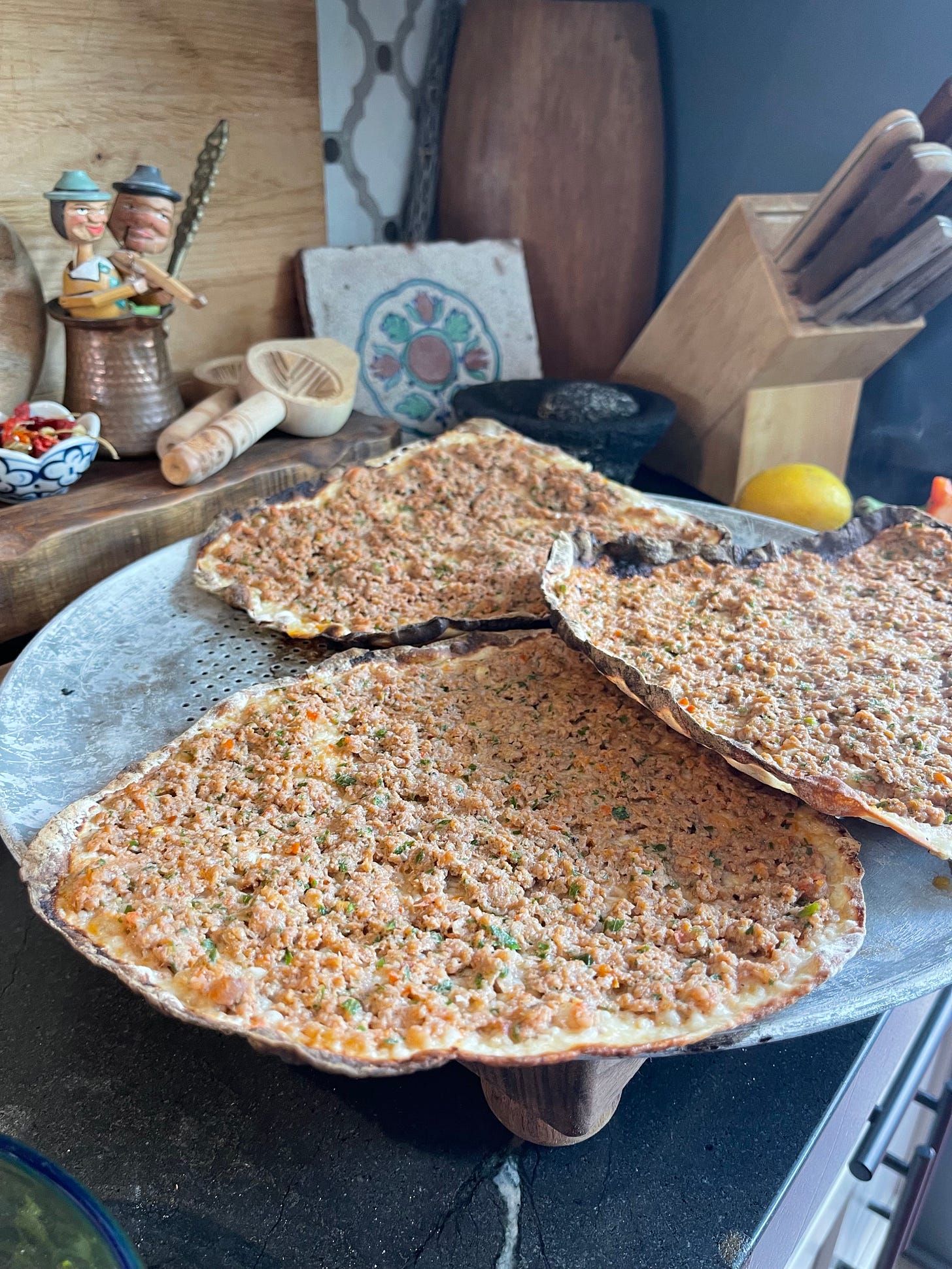Lahmacun is a crisp canvas of dough, generously blanketed with a blend of minced meat and vegetables. Baked until crisp, this beloved street food shines when paired with sumac-tossed onions, a lush garnish of fresh parsley, and a zesty splash of lemon juice. For the full recipe, scroll down.
As with many foods in Central Asia, the Levant, and the broader Middle East, the origins of lahmacun (lamadjo in Armenian) are debated. The true origin of lahmacun is shrouded in mystery, with Türkiye and Armenia both laying claim to its creation. Particularly popular in Türkiye, Armenia, Israel, Lebanon, and Syria, this beloved dish carries an Arabic name.
In Arabic, "Lahmacun" (لحم بعجين/Lahm Bi-Ajin) translates to "meat with dough." The term is derived from "lahm," meaning meat, and "bi ajin," meaning with dough or paste. It describes the dish’s key elements: a finely chopped mixture of meat and vegetables that is spread onto the dough before baking, creating a flavorful topping.
Often labeled as “Turkish-style pizza,” this comparison can be reductive. Using "pizza" as a reference imposes a hierarchy that overlooks lahmacun's rich, distinct heritage. Lahmacun deserves recognition on its own merits and doesn’t need comparisons to define its significance. In reality, it’s quite different from pizza, aside from the shared concept of dough topped with various ingredients.
Türkiye’s southeastern region, particularly Urfa and Gaziantep, has a long history with lahmacun. However, during the Ottoman Empire, lahmacun began to gain widespread popularity as a street food. Its popularity truly soared in Türkiye during the 1950s and 1960s.
During my time living in Türkiye, especially in Istanbul, lahmacun became a staple in our weekly food rotation. We were fortunate to have an abundance of exceptional lahmacun shops in Beşiktaş and Kadıköy. Always accompanied by a refreshing bottle of ayran, this meal consistently hits the spot. Lahmacun is quick, filling, tasty, refreshing, affordable, and portable. Plus, the fresh vegetable garnish helps soothe any concerns about eating healthily.
Regardless of its origins, lahmacun represents more than just the combination of its ingredients. Through this dish, we glimpse the political tensions, nationalistic pride, and undeniable connections between different peoples and nations. It serves as a reminder that food transcends national borders, embodying an identity that evolves beyond specific places and times. Despite our tendency to claim ownership of food and recipes, lahmacun invites us to embrace the ambiguity of its origins and indulge in its rich, shared history.
My Recipe for At-home Lahmacun
Servings: 4 (2 lahmuchun per person)
I’m using ground beef for my lahmacun recipe, but you can easily substitute half of it with lamb if you prefer. I’ve included butter and thick, strained whole-milk yogurt to boost the fat content (per a suggestion from Refika). Keep in mind that “authenticity” isn’t my main aim here. I’m focusing on recreating the flavors of lahmacun that my family enjoys, and you’re welcome to do the same. Feel free to use this as a base and make it your own.
Ingredients for the Meat Mixture:
1 medium yellow onion, quartered
2 medium cloves of garlic
1/2 cup canned whole tomatoes
1/2 red pepper, roughly chopped
1 generous handful of sprigs of parsley
1.5 tablespoons whole milk thick strained yogurt
1 tablespoon tomato paste/pepper paste
1 teaspoon cumin
1 teaspoon salt
1 teaspoon black pepper
1 teaspoon pepper flakes (pul biber or Aleppo pepper)
1 teaspoon Urfa biber (or any smoked pepper like smoked paprika)
200 grams of ground beef
1.5 tablespoon of butter
Ingredients for the Dough:
300 grams (about 2 cups) of all-purpose flour
½ teaspoons instant yeast
½ teaspoon sugar
180 ml water (3/4 cup)
1 teaspoon salt
For the Garnish:
1 lemon, sliced for garnish
1 medium onion, sliced thinly into half-moons, tossed in 1 tbsp sumac
1 bunch parsley, roughly chopped
1 cup lettuce, shredded
2 tomatoes, slices
Optional Garnish: 1/2 cup walnuts, chopped and a drizzle of pomegranate molasses
To make the Meat Mixture:
Slowly add the ingredients for the meat mixture to a food processor, fully incorporating each ingredient before adding the next.
To Make the Dough:
Mix the flour, yeast, sugar, water, and salt in a bowl and knead for 2 minutes.
When the dough becomes smooth and less sticky, cover it with a damp cloth and let it rest for about 10 minutes in a warm place.
Divide the dough into 8 equal balls. Dust the work surface and the rolling pin with flour and roll out the balls around 10-12 in.
To Make the Lahmacun:
Heat the oven to as high as it can go,
For a pizza oven or Ooni, heat up to 900°F (480°C)
For a regular over, heat to 450° (235°C)
Preheat a pizza stone or cast iron tray in the oven for extra heat if using a regular oven.
Place the rolled-out dough on a peel and shake off the excess flour.
Spread 3-4 tablespoons of the meat mixture on the dough.
Slide the lahmacun into the hot oven and bake until crisp on the bottom and cooked on top.
For a pizza over or Ooni, we set it to 900°F and then baked it for about 3-5 minutes, rotating halfway through.
For a regular home oven, bake at 450°F for about 10 to 12 minutes, rotating halfway through.
Remove it from the oven when the dough has a crispy bottom and the meat is cooked and juicy.
Garnish with a squeeze of lemon, a sprinkle of parsley, and tomatoes, lettuce, and onions tossed in sumac. For a different twist, you can also sprinkle with walnuts and drizzle with pomegranate molasses.
Roll up the lahmacun and take a big bite—welcome to gastronomic bliss!






